Family
 When the automobile was invented, everyone rightly thought it was going to be the “end all, beat all” of transportation inventions. In many ways, it probably was just that…at that time anyway, but as with any form of transportation, when it’s very new, it’s also very flawed. By its very nature, and invention is often trial and error. On November 30, 1965, a 32-year-old lawyer named Ralph Nader saw something in the automobile that caused him to become very concerned…concerned enough to write a book about his findings. Nader called his book Unsafe at Any Speed: The Designed-In Dangers of the American Automobile. Just the title of the book is enough to worry the thinking consumer…or maybe what would have been the “overthinking” consumer.
When the automobile was invented, everyone rightly thought it was going to be the “end all, beat all” of transportation inventions. In many ways, it probably was just that…at that time anyway, but as with any form of transportation, when it’s very new, it’s also very flawed. By its very nature, and invention is often trial and error. On November 30, 1965, a 32-year-old lawyer named Ralph Nader saw something in the automobile that caused him to become very concerned…concerned enough to write a book about his findings. Nader called his book Unsafe at Any Speed: The Designed-In Dangers of the American Automobile. Just the title of the book is enough to worry the thinking consumer…or maybe what would have been the “overthinking” consumer.
Still, the book became a best-seller right away. It also triggered the passage of the National Traffic and Motor Vehicle Safety Act of 1966…seat-belt laws in 49 states…all but New Hampshire. It also triggered a number of other road-safety initiatives. The original automobile really did have some serious safety flaws, and while a lot of people would argue that the seatbelt doesn’t prevent death in accidents, the reality is that it prevents many of those deaths, and the ones that seatbelts don’t prevent, are so bad that nothing would have prevented death.
These days, Ralph Nader is known for his role in national politics, running unsuccessfully for President of the United States four times…running with the Green Party in 1996 and 2000, the Reform Party in 2004, and as an independent in 2008. In each campaign, Nader said he sought to highlight under-reported issues and a perceived need for electoral reform. He received nearly three million votes during his 2000 candidacy, but also stirred controversy over allegations that his campaign helped Republican candidate George W Bush win in a highly contested election against Democratic candidate Al Gore.
Nader’s book placed the automobile in a negative light for the 50 years prior to the releases of the book, saying  that “the automobile has brought death, injury, and the most inestimable sorrow and deprivation to millions of people.” His real complaint was that technology existed at that time to make cars safer, but automakers had little incentive to use them. He thought that the automakers skipped the important steps that could have brought about a much safer vehicle. He wrote that on the contrary, “the gigantic costs of the highway carnage in this country support a service industry,” meaning doctors, lawyers, police officers, morticians, with no real plans to change things and “there is little in the dynamics of the automobile accident industry that works for its reduction.”
that “the automobile has brought death, injury, and the most inestimable sorrow and deprivation to millions of people.” His real complaint was that technology existed at that time to make cars safer, but automakers had little incentive to use them. He thought that the automakers skipped the important steps that could have brought about a much safer vehicle. He wrote that on the contrary, “the gigantic costs of the highway carnage in this country support a service industry,” meaning doctors, lawyers, police officers, morticians, with no real plans to change things and “there is little in the dynamics of the automobile accident industry that works for its reduction.”
Nader’s book brought to light some of the harsh truths, or rather serious flaws, about and in cars and car companies that auto-safety advocates had known for some time, and seemingly done nothing about. Nader pushed hard against the automakers, and in 1956, at a series of Congressional hearings on traffic safety, doctors and other experts lamented the “wholesale slaughter” on American highways. Safety measures had all but been ignored, and that year, nearly 40,000 people were killed in cars, with no sign of a decrease in numbers on the horizon. If the consumers wanted the much-needed safety features, they could pay extra for a Ford with seatbelts and a padded dashboard, but very few did. It was estimated that only 2% of Ford buyers took the $27.00 seatbelt option. The auto industry not only made it more costly to get the safety features, but downplayed the importance of it.
In his book, Nader particularly ranted against the Chevy Corvair, a sporty car with a swing axle and rear–mounted engine that was introduced in 1959, saying that the car epitomized the triumph of “stylistic 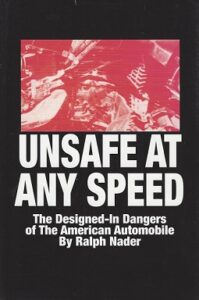 pornography over engineering integrity.” The swing axle made the rear end unstable, causing it to “tuck under during turns and skid or roll over much more frequently than other cars did.” As it turned out, a 1972 government study vindicated the Corvair, finding that it was just as safe as any other car. I couldn’t say one way or another, but Nader called that study “rigged.” Nevertheless, the damage was done. The Corvair became an icon of dangerous, even deadly design, which was later proven to e the case. The last one rolled off the assembly line in 1969. I suppose the auto industry is a heavily funded group, and it would be easy to “fix” the numbers to say what they wanted to say.
pornography over engineering integrity.” The swing axle made the rear end unstable, causing it to “tuck under during turns and skid or roll over much more frequently than other cars did.” As it turned out, a 1972 government study vindicated the Corvair, finding that it was just as safe as any other car. I couldn’t say one way or another, but Nader called that study “rigged.” Nevertheless, the damage was done. The Corvair became an icon of dangerous, even deadly design, which was later proven to e the case. The last one rolled off the assembly line in 1969. I suppose the auto industry is a heavily funded group, and it would be easy to “fix” the numbers to say what they wanted to say.
Nader’s book mobilized a mass movement. Armed with the truth, ordinary consumers banded together to demand safer cars and better laws. When consumers take a stand, things can, and do happen. Today, seat belts, air bags, anti-lock brakes and other innovations are standard features in almost every new car. I don’t know what kind of a politician Ralph Nader was or is, but in this one thing anyway, he did something good.
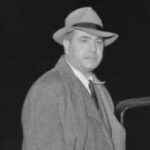
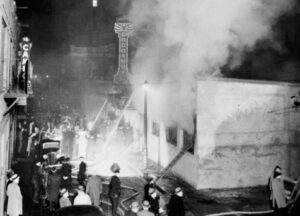 One of the saddest realities is that safety standards are often the result of a tragedy. That is exactly what happened during what is still the deadliest nightclub fire in the world, and the second-deadliest single-building fire…after the Iroquois Theatre fire. On November 28, 1942, Cocoanut Grove was well known as one of Boston’s most popular nightspots. The club attracted many celebrity guests and Boston’s most elite citizens. The fire was a tragedy that later became the catalyst for change in fire prevention, and how to survive a fire. Unfortunately, 492 people have to pay for these lessons with their lives.
One of the saddest realities is that safety standards are often the result of a tragedy. That is exactly what happened during what is still the deadliest nightclub fire in the world, and the second-deadliest single-building fire…after the Iroquois Theatre fire. On November 28, 1942, Cocoanut Grove was well known as one of Boston’s most popular nightspots. The club attracted many celebrity guests and Boston’s most elite citizens. The fire was a tragedy that later became the catalyst for change in fire prevention, and how to survive a fire. Unfortunately, 492 people have to pay for these lessons with their lives.
The Cocoanut Grove was owned by Barnet “Barney” Welansky, who was closely connected to the Mafia and to Mayor Maurice J Tobin. As often happens, anyone connected to the Mafia and/or a politician, also believes they are above the law. They do things the way they want to, cutting corners to save a buck, and then they expect their connections to get them out of trouble when and if it shows up. Welansky was no different. In the building and running of his nightclub, fire regulations had been pretty much disregarded, because as we all know, regulations are for other people to follow, but not, in this case, the Cocoanut Grove. There was a constant concern about people sneaking in the exit doors, so rather than pay for security to prevent such actions, some exit-doors had been locked to prevent said unauthorized entry. The decor wasn’t always checked for safety either, like the elaborate palm tree décor, which contained flammable materials. Also, because of wartime shortages of freon, the air-conditioning used flammable gas to cool the club. Welansky often disregarded the capacity laws to bring in bigger profits, and so it was that during the first Thanksgiving weekend since the United States had entered World War II, the Grove was filled to more than twice its legal capacity.
When disaster struck, it was in the form of a fire that was initiated by an electrical short and fueled by methyl chloride in the air conditioning unit. Once it started, the fire and its associated smoke spread rapidly through all 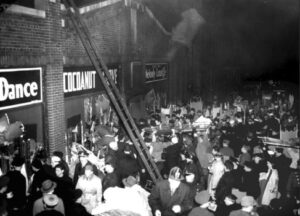
 areas of the club. The problem…people were unable to escape due in part to locked exit doors. The only saving grace was that the local hospitals were especially well prepared to treat the casualties, because they had been rehearsing emergency drills in response to possible wartime attacks on the East Coast. Had that not been the case, the death toll would have likely included the 130 survivors too. If “good” can be said to come from tragedy, it would come in the form of the demonstrated value of the new blood banks and stimulated important advances in the treatment of burn victims. As always happens after a tragedy, many new laws were enacted for public establishments, including the banning of flammable decorations, a provision that emergency exits must be kept unlocked (from the inside), and that revolving doors cannot be the only exit.
areas of the club. The problem…people were unable to escape due in part to locked exit doors. The only saving grace was that the local hospitals were especially well prepared to treat the casualties, because they had been rehearsing emergency drills in response to possible wartime attacks on the East Coast. Had that not been the case, the death toll would have likely included the 130 survivors too. If “good” can be said to come from tragedy, it would come in the form of the demonstrated value of the new blood banks and stimulated important advances in the treatment of burn victims. As always happens after a tragedy, many new laws were enacted for public establishments, including the banning of flammable decorations, a provision that emergency exits must be kept unlocked (from the inside), and that revolving doors cannot be the only exit.
The investigation centered around Welansky’s blatant disregard for the safety of the very patrons who gave him his wealth by their continued patronage of his establishment. An official report revealed that “the Cocoanut Grove had been inspected by a captain in the Boston Fire Department (BFD) just ten days before the fire and declared safe. Further, it was found that the Grove had not obtained any licenses for operation for several years. There were no food handlers’ permits and no liquor licenses. Stanley Tomaszewski, the busboy who had allegedly started the fire, was underage and should not have been working there. Moreover, the recent remodeling of the Broadway Lounge had been done without building permits, using unlicensed contractors.” Tomaszewski testified at the inquiry and was exonerated, as he was not responsible for the flammable decorations or the life safety code violations. While declared innocent, Tomaszewski would pay for the “crime” anyway, in the form of being “ostracized for much of his life because of the fire.” Tomaszewski died in 1994. In the end, the blame was rightly assigned to Welansky, for violation of the existing safety standards, and upon 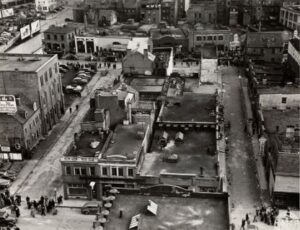
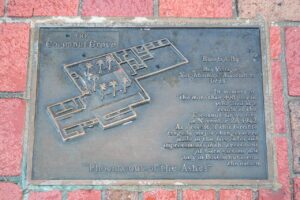 his conviction in 1943, Welansky was sentenced to 12–15 years in prison. Welansky served nearly four years before being quietly pardoned by Tobin, who had been elected governor of Massachusetts since the fire. In December 1946, diagnosed with cancer, Welansky was released from Norfolk Prison, telling reporters, “I wish I’d died with the others in the fire.” Nine weeks later on 27 Jan 1947 the cancer took his life. He was 49 years old.
his conviction in 1943, Welansky was sentenced to 12–15 years in prison. Welansky served nearly four years before being quietly pardoned by Tobin, who had been elected governor of Massachusetts since the fire. In December 1946, diagnosed with cancer, Welansky was released from Norfolk Prison, telling reporters, “I wish I’d died with the others in the fire.” Nine weeks later on 27 Jan 1947 the cancer took his life. He was 49 years old.

 My niece, Machelle Moore is going through more changes this year. Her son, Weston moved to Butte, Montana a year or so ago, and is doing very well there. For Machelle, and her husband Steve, it means that they don’t get to see their son as much as they used to, and certainly not as much as they would like to. Now, with their son, Easton graduating from high school last summer, the likelihood of him moving out of the house becomes very real as time goes on. It’s a time of life, that all parents face at some point. The whole Empty Nest Syndrome is alive and well in families at this point in life.
My niece, Machelle Moore is going through more changes this year. Her son, Weston moved to Butte, Montana a year or so ago, and is doing very well there. For Machelle, and her husband Steve, it means that they don’t get to see their son as much as they used to, and certainly not as much as they would like to. Now, with their son, Easton graduating from high school last summer, the likelihood of him moving out of the house becomes very real as time goes on. It’s a time of life, that all parents face at some point. The whole Empty Nest Syndrome is alive and well in families at this point in life.
The good news for Machelle is that she and Steve seriously love to do the same things. Getting out in the  mountains, going camping, walking the mountain top trails, and looking for rocks, are all favorite activities for Machelle and Steve. While they are active when they are out in the mountains, it’s the peace and quiet they really crave, I think. Everyone’s life is so busy, these days. To have a weekend in the mountains…just you and the birds…it doesn’t get better than that. I’m like Machelle and Steve in that way. While I don’t go camping, I love hiking in the mountains…just me and the birds. There is something about walking in nature, especially among the fir trees. The scent is Heavenly, almost like being in a Christmas tree sales lot…except in nature, not in the city.
mountains, going camping, walking the mountain top trails, and looking for rocks, are all favorite activities for Machelle and Steve. While they are active when they are out in the mountains, it’s the peace and quiet they really crave, I think. Everyone’s life is so busy, these days. To have a weekend in the mountains…just you and the birds…it doesn’t get better than that. I’m like Machelle and Steve in that way. While I don’t go camping, I love hiking in the mountains…just me and the birds. There is something about walking in nature, especially among the fir trees. The scent is Heavenly, almost like being in a Christmas tree sales lot…except in nature, not in the city.
Life is changing for Machelle. She is beyond the “mom with school aged kids at home” and into the “mom of two adult men” stage. It’s a different world, and one that we both dread and eagerly anticipate. We are so proud of our children and the accomplishments they have made, and we are excited to see what comes next for 
 them. We consider the possibility of marriage and children for them, whether we tell them we are thinking about that or not. Still, we think back on the cute little babies they were, crawling, first teeth, first steps, so many firsts. In reality, this is another first…only this time, for Machelle and for Steve. First trips without the kids, first school year beginning without having a student in school, and so many other firsts to come. today is Machelle’s birthday. Happy birthday Machelle!! Have a great day!! We love you!!
them. We consider the possibility of marriage and children for them, whether we tell them we are thinking about that or not. Still, we think back on the cute little babies they were, crawling, first teeth, first steps, so many firsts. In reality, this is another first…only this time, for Machelle and for Steve. First trips without the kids, first school year beginning without having a student in school, and so many other firsts to come. today is Machelle’s birthday. Happy birthday Machelle!! Have a great day!! We love you!!
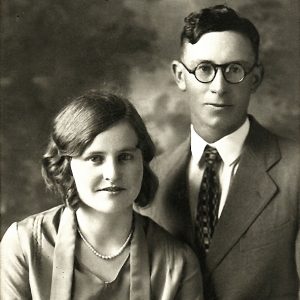
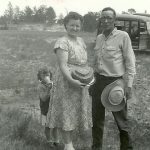 My husband, Bob Schulenberg’s grandfather, Robert Knox lived an interesting life…at least those early married years, when he and Grandma, Nettie Knox only had one child…Bob’s mother, Joann Schulenberg. Their home was a sheepherder’s wagon, and it was small. My mother-in-law and their daughter, Joann Schulenberg, often told me about her days as a small child living in that wagon. She got her first tricycle while living there, and that winter found her riding her tricycle from door to bed and back again over and over. I wonder if her parents were almost driven crazy with all the activity in that small space.
My husband, Bob Schulenberg’s grandfather, Robert Knox lived an interesting life…at least those early married years, when he and Grandma, Nettie Knox only had one child…Bob’s mother, Joann Schulenberg. Their home was a sheepherder’s wagon, and it was small. My mother-in-law and their daughter, Joann Schulenberg, often told me about her days as a small child living in that wagon. She got her first tricycle while living there, and that winter found her riding her tricycle from door to bed and back again over and over. I wonder if her parents were almost driven crazy with all the activity in that small space.
I know that a shepherd is responsible for the lives of the sheep, but in Biblical days and even days more modern in the past, the way to protect the flock was to kill the predator using a stone, or stick. Of course, with 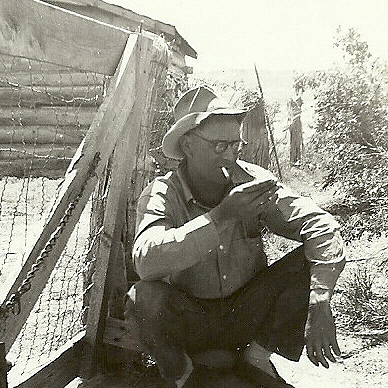 the invention of guns, the task became easier. There were guns by the time Grandpa Knox was herding sheep, so I’m guessing that was how he killed the coyotes that might have tried to kill the sheep. Being a shepherd is a hard and often lonely job, but when a man can have his family there too, it’s not so bad.
the invention of guns, the task became easier. There were guns by the time Grandpa Knox was herding sheep, so I’m guessing that was how he killed the coyotes that might have tried to kill the sheep. Being a shepherd is a hard and often lonely job, but when a man can have his family there too, it’s not so bad.
Grandpa was also a master gardener, and this was something I saw for myself. The whole family reaped the benefits of his rather extensive garden. When I joined the family in 1975, I had never canned vegetables, but my mother-in-law was a willing teacher, and Grandpa’s garden supplied all the veggies I could possibly have needed…and more. Those were good years. The garden grew well, and the vegetables were plenty. We had all we could ask or need. Grandpa enjoyed helping out the family by caring for the garden, because it gave him purpose. As people age, they can sometimes begin to feel useless, but Grandpa Knox have no such concerns. He knew that the work he was doing was good work, and that the whole family was healthier because of his 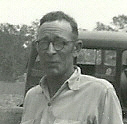
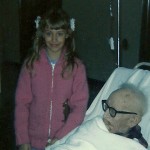 hard work.
hard work.
Grandpa Knox left is in 1985, at the age of 77 years. Cancer took its toll on his body, and finally he succumbed, but not before receiving a great granddaughter, Machelle Moore as a birthday gift in 1976. The had a few years to get to know each other before he went home, and I know that the gift of Machelle made him very happy. I also know that Machelle misses him, especially on their birthday. Happy birthday in Heaven, Grandpa Knox. We love and miss you very much.
 Pirates!! Men who sail the seas in search of prey…ships filled with loot, or even just people’s possessions. That is a fact, but not all pirates were, or are, men. In fact, the most successful pirate was a woman. Ching Shih was born in 1775 in Guangdong, China. She actually started out as a prostitute in China. Then her life changed. The Commander of the pirate band, the Red Flag Fleet, Cheng I (Zheng Yi), bought and married her. That could have been viewed as a terrible event in her life, but when you consider where she started, maybe not. Her new husband could have been abusive to her, but rather than just viewing her as a wife, he considered her his equal and she
Pirates!! Men who sail the seas in search of prey…ships filled with loot, or even just people’s possessions. That is a fact, but not all pirates were, or are, men. In fact, the most successful pirate was a woman. Ching Shih was born in 1775 in Guangdong, China. She actually started out as a prostitute in China. Then her life changed. The Commander of the pirate band, the Red Flag Fleet, Cheng I (Zheng Yi), bought and married her. That could have been viewed as a terrible event in her life, but when you consider where she started, maybe not. Her new husband could have been abusive to her, but rather than just viewing her as a wife, he considered her his equal and she 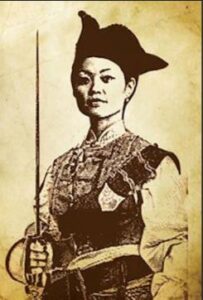 became an active pirate commander in the fleet. Ok, being a pirate was probably not the greatest career she could have had, but it was better than her past…to a degree anyway.
became an active pirate commander in the fleet. Ok, being a pirate was probably not the greatest career she could have had, but it was better than her past…to a degree anyway.
Her marriage came with the promise to cede to her the control of half of his pirate fleet and business. I’m sure the pirate gang were wondering what her husband was thinking, but Ching Shih soon earned the respect of her fellow pirates…no small feat for a woman. The other men may not have liked it at first, but by the time Ching Shih’s husband died, they trusted her completely…so much so, in fact, that she became the captain of the fleet. That was actually huge for Ching Shih, and under her leadership, the Red Flag Fleet grew to over 300 warships, with a possible 1,200 more support ships. She even had a possible 40,000 – 80,000 men, women, and  children, all of whom counted on her for their “living.” I guess you could call pirating a living…as much as bank robbery, I suppose.
children, all of whom counted on her for their “living.” I guess you could call pirating a living…as much as bank robbery, I suppose.
Over the years that Ching Shih ran the Red Flag Fleet, they terrorized the waters around China. She soon became known as the “Terror of South China.” The government tried their best to take down the ruthless pirates, but they were totally unsuccessful. Ching Shih was so good at what she did, that the Chinese government was at a loss to stop the band of pirates. Finally, she suffered a series of defeats at the hands of the Portuguese Navy, but the Qing imperial government chose to allow her band to keep the wealth gained from piracy, provided she retire in peace. She agreed, and the Chinese government pardoned Ching Shih and her entire fleet…just to get them off the high seas!! To this day, she is believed to be the most notorious, and the most successful pirate in history. Ching Shih died in 1844 in Guangdong, China. She was 69 years old.
 As a child, I remember that when we were on a road trip, we would look for a lone tree. We thought it was fun to find a tree that had managed to grow in a place that was so far away from other trees. Of course, before long, we realized that most of these trees that we thought were “lone” trees, had “friends” just over the top of a hill. Every once in a while, however, we found a tree that for all intents and purposes looked like a true “lone” tree. We called it that if we couldn’t see another tree, within our view, but there is a tree that apparently really qualified as a “lone” tree. It was called the Tree of Tenere, and it was located in Niger’s Sahara Desert.
As a child, I remember that when we were on a road trip, we would look for a lone tree. We thought it was fun to find a tree that had managed to grow in a place that was so far away from other trees. Of course, before long, we realized that most of these trees that we thought were “lone” trees, had “friends” just over the top of a hill. Every once in a while, however, we found a tree that for all intents and purposes looked like a true “lone” tree. We called it that if we couldn’t see another tree, within our view, but there is a tree that apparently really qualified as a “lone” tree. It was called the Tree of Tenere, and it was located in Niger’s Sahara Desert.
The Tree of Tenere was a very old tree. In fact, for roughly three centuries Niger’s Sahara Desert was home to the tree, which was widely believed to be the most isolated tree on the planet. Apparently, this lonely acacia tree was the only tree for 250 miles. The tree was well known and was even used as a much-needed landmark by countless desert caravans for generations. When traveling across the desert, with nothing to use for guidance, it would be easy to get lost. The tree proudly showed the way across, keeping many a traveler from ending up as a casualty of the desert.
One day, the most horrific and truly shocking event happened. The Tree of Tenere got hit by a truck. It was in 1973, and it is assumed that it was a drunk driver who managed to plow into the only object for hundreds of miles while following an old caravan route. There was simply nothing else out there. It almost makes you wonder how the drunk driver (or whoever it was) could have managed to hit that particular spot. It was like  hitting a needle in a haystack. Hundreds of miles of desert sand, and one small tree. Nevertheless, hit it they did, and the spindly little tree was snapped in half. Most likely, the drunk driver didn’t even know he had hit anything. Whatever the case may be, the important little, truly “lone” tree was dead. So important had it been that the acacia’s dried trunk is now on display in the Niger National Museum, and a statue memorializing the natural wonder has taken its place in the remote desert. The landmark was too important to lose it. It is said that here is a silver lining though. It is now officially impossible to be accused of bad driving in Niger’s Saraha Desert, because “Hey, at least I didn’t kill that tree.”
hitting a needle in a haystack. Hundreds of miles of desert sand, and one small tree. Nevertheless, hit it they did, and the spindly little tree was snapped in half. Most likely, the drunk driver didn’t even know he had hit anything. Whatever the case may be, the important little, truly “lone” tree was dead. So important had it been that the acacia’s dried trunk is now on display in the Niger National Museum, and a statue memorializing the natural wonder has taken its place in the remote desert. The landmark was too important to lose it. It is said that here is a silver lining though. It is now officially impossible to be accused of bad driving in Niger’s Saraha Desert, because “Hey, at least I didn’t kill that tree.”
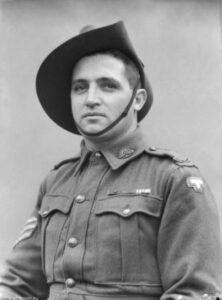 Lieutenant Thomas “Diver” Derrick was one of the 2/48th Battalion of the Australian 9th Infantry division battalion’s most decorated and beloved soldiers, serving in Australia’s most decorated unit in World War II. He was the best of the best, but it was after one event that he actually gained notoriety. Derrick was born on March 20, 1914, at the McBride Maternity Hospital in the Adelaide suburb of Medindie, South Australia, to David Derrick, a laborer from Ireland, and his Australian wife, Ada (née Whitcombe). The Derricks were poor, and Tom often walked barefoot to attend Sturt Street Public School and later Le Fevre Peninsula School. In 1928, aged fourteen, Derrick left school and found work in a bakery. By this time, he had developed a keen interest in sports, particularly cricket, Australian Rules Football, boxing and swimming; his diving in the Port River earned him the nickname of “Diver.”
Lieutenant Thomas “Diver” Derrick was one of the 2/48th Battalion of the Australian 9th Infantry division battalion’s most decorated and beloved soldiers, serving in Australia’s most decorated unit in World War II. He was the best of the best, but it was after one event that he actually gained notoriety. Derrick was born on March 20, 1914, at the McBride Maternity Hospital in the Adelaide suburb of Medindie, South Australia, to David Derrick, a laborer from Ireland, and his Australian wife, Ada (née Whitcombe). The Derricks were poor, and Tom often walked barefoot to attend Sturt Street Public School and later Le Fevre Peninsula School. In 1928, aged fourteen, Derrick left school and found work in a bakery. By this time, he had developed a keen interest in sports, particularly cricket, Australian Rules Football, boxing and swimming; his diving in the Port River earned him the nickname of “Diver.”
Derrick’s notorious accomplishment came during the Battle of Sattelberg in New Guinea in November 1943. His battalion…the 2/48th was participating in the fight. Over a period of two hours, the Australians made several attempts to clamber up the slopes to reach their objective, but each time they were repulsed by intense machine gun fire and grenade attacks. As dusk fell, it appeared impossible to reach the objective or even hold the ground already gained, and the company was ordered the men to retreat. That order brought about an unusual response in Lieutenant Derrick, who was quoted as saying, “Bugger the CO [commanding officer]. Just give me twenty more minutes and we’ll have this place. Tell him I’m pinned down and can’t get out.” With that, then Sergeant Tom Derrick hoisted the Australian Red Ensign at Sattelberg, New Guinea. He moved forward with his platoon, and Derrick attacked a Japanese post 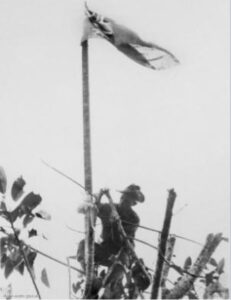 that had been holding up the advance. He quickly destroyed the position with grenades and ordered his second section around to the right flank. The section immediately came under heavy machine gun and grenade fire from six Japanese posts, but that didn’t stop Derrick. Clambering up the cliff face under heavy fire, Derrick held on with one hand while lobbing grenades into the weapon pits with the other. Someone said he was like “a man…shooting for [a] goal at basketball.” Derrick climbed further up the cliff and in full view of the Japanese, he continued to attack the posts with grenades before following up with accurate rifle fire. True to his word, within twenty minutes, he had reached the peak and cleared seven posts…all while the demoralized Japanese defenders fled from their positions to the buildings of Sattelberg. I suppose that if the maneuver had ended differently, Derrick might have been punished for disobeying the order of his commanding officer, but as it was, how could they discipline him for such a one-man-show of prowess.
that had been holding up the advance. He quickly destroyed the position with grenades and ordered his second section around to the right flank. The section immediately came under heavy machine gun and grenade fire from six Japanese posts, but that didn’t stop Derrick. Clambering up the cliff face under heavy fire, Derrick held on with one hand while lobbing grenades into the weapon pits with the other. Someone said he was like “a man…shooting for [a] goal at basketball.” Derrick climbed further up the cliff and in full view of the Japanese, he continued to attack the posts with grenades before following up with accurate rifle fire. True to his word, within twenty minutes, he had reached the peak and cleared seven posts…all while the demoralized Japanese defenders fled from their positions to the buildings of Sattelberg. I suppose that if the maneuver had ended differently, Derrick might have been punished for disobeying the order of his commanding officer, but as it was, how could they discipline him for such a one-man-show of prowess.
Following his successful one-man-attack on the enemy, Derrick returned to his platoon, where he gathered his first and third sections in preparation for an assault on the three remaining machine gun posts in the area. While the platoon was attacking the posts, Derrick personally rushed forward on four separate occasions and threw his grenades at a range of about 8 yards, before all three were silenced. Derrick’s platoon held their position that night, before the 2/48th Battalion moved in to take Sattelberg unopposed the following morning. I’m sure that brought a level of shock to the commanding officer, who had expected a much different outcome and a much different enemy the next morning. The, then proud, battalion commander insisted that Derrick personally hoist the Australian flag over the town. It was raised at 10:00am on November 25, 1943.
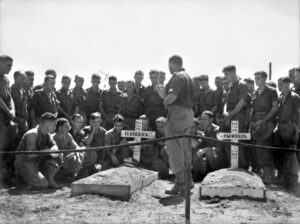 The final assault on Sattelberg was later dubbed “Derrick’s Show” within the 2/48th Battalion. Derrick was already a celebrity within the 9th Division, but this action brought him to wide public attention. I suppose that could have been seen as just Derrick’s irritation over the retreat, but it also could have and was taken as disobeying an order. Derrick had advanced on multiple Japanese machine gun positions, uphill through the jungle, while under covering fire from his squadmates…and he did it by himself. In all, he cleared out 10 enemy positions, helping his unit accomplish their objective and receiving the Victoria Cross for his efforts. Unfortunately, Derrick was killed late in World War II, suffering grievous injuries at the Battle of Tarakan in May 1945.
The final assault on Sattelberg was later dubbed “Derrick’s Show” within the 2/48th Battalion. Derrick was already a celebrity within the 9th Division, but this action brought him to wide public attention. I suppose that could have been seen as just Derrick’s irritation over the retreat, but it also could have and was taken as disobeying an order. Derrick had advanced on multiple Japanese machine gun positions, uphill through the jungle, while under covering fire from his squadmates…and he did it by himself. In all, he cleared out 10 enemy positions, helping his unit accomplish their objective and receiving the Victoria Cross for his efforts. Unfortunately, Derrick was killed late in World War II, suffering grievous injuries at the Battle of Tarakan in May 1945.

 Some years, it seems like we can struggle to find something to be thankful for on Thanksgiving Day. Of course, Thanksgiving Day isn’t the only day we should be thankful. We should be thankful every day, but t isn’t always easy. Take this year, for example. Inflation is high, there are “shortages” of necessities. Every day there is a warning of another new Covid strain. Jobs are scarce. Many people don’t see this as a year to be thankful for, and yet it is. It’s in times like these that we need to actually look for things to be thankful for. True, there may be many things that are difficult right now, but if we look, we can find something that we are thankful for…and being thankful in our current circumstances is of vital importance.
Some years, it seems like we can struggle to find something to be thankful for on Thanksgiving Day. Of course, Thanksgiving Day isn’t the only day we should be thankful. We should be thankful every day, but t isn’t always easy. Take this year, for example. Inflation is high, there are “shortages” of necessities. Every day there is a warning of another new Covid strain. Jobs are scarce. Many people don’t see this as a year to be thankful for, and yet it is. It’s in times like these that we need to actually look for things to be thankful for. True, there may be many things that are difficult right now, but if we look, we can find something that we are thankful for…and being thankful in our current circumstances is of vital importance.
The Apostle Paul wrote in Philippians 4:12-13, “I know both how to have a little, and I know how to have a lot. In any and all circumstances I have learned the secret of being content—whether well fed or hungry, whether in abundance or in need. I am able to do all things through Him who strengthens me.” Now, there is the epitome of being thankful…being thankful when we have little and when we have much. All too often, we think that we have to be in abundance in order to have anything to be thankful for. Of course, it’s easy to be thankful when you are “rolling in dough,” but not so easy when you’re not. Still, we should be thanking God every day, for everything…not just for the big things that our greed wants, but for things like life, family, happiness, and health. These are the things that we often take for granted, but that we should always be thankful for.
Some years it is harder to find things to be thankful for…it’s true, but I think that in the years when we have to think about it or search for a reason to be thankful, we can actually find ourselves feeling even more thankful 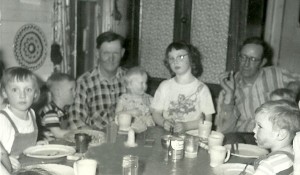
 than in the years that seem to have plenty. I think of families who have survived a disaster. Their home is gone, but they are alive. Do you think that they are thankful? Absolutely!! We might think, but their home is gone, how can they not feel loss? Well, the answer is, they do feel a loss, but they also feel thankful, because their family is intact. Sometimes, that is the sweetest tone of thankfulness there is.
than in the years that seem to have plenty. I think of families who have survived a disaster. Their home is gone, but they are alive. Do you think that they are thankful? Absolutely!! We might think, but their home is gone, how can they not feel loss? Well, the answer is, they do feel a loss, but they also feel thankful, because their family is intact. Sometimes, that is the sweetest tone of thankfulness there is.

 My niece, Kelli Schulenberg is totally an outdoorsy girl. She loves to go camping, hiking, and just hanging out by a campfire with her husband, my nephew, Barry Schulenberg and their dog Scout. They have camped out many places, but they always seem to head back to the Big Horn Mountains. It’s close to home and that might be the reason they choose the Big Horns or Casper Mountain for their camping and hiking. Their dog loves to go along with them and tries to run the show. Kelli and Barry
My niece, Kelli Schulenberg is totally an outdoorsy girl. She loves to go camping, hiking, and just hanging out by a campfire with her husband, my nephew, Barry Schulenberg and their dog Scout. They have camped out many places, but they always seem to head back to the Big Horn Mountains. It’s close to home and that might be the reason they choose the Big Horns or Casper Mountain for their camping and hiking. Their dog loves to go along with them and tries to run the show. Kelli and Barry 
 also like to ride their bicycles on the mountain, as well as on some of the local trails inside the city limits of Casper, and in the local dog park, which is nice for Scout.
also like to ride their bicycles on the mountain, as well as on some of the local trails inside the city limits of Casper, and in the local dog park, which is nice for Scout.
While Kelli isn’t a big fan of Winter, she surprises me a little in that she rather likes cross country skiing and snow shoeing. Most of us “Winter Haters” would refuse to go out in snowy weather, at least any more than we absolutely had to. Yes, I’m a “Winter Hater” too, in case you couldn’t tell. Nevertheless, Kelli like to go cross country skiing, and I have to say, “Cudos to you, Kelli!!” Kelli really loves the mountains, and that is very likely the reason that she adds a few wintertime outings to her fitness calendar. She also loves to stay in shape, and the different sports things she does help her do that quite well. A dog, who is always up for an outing helps too. Dog owners tend to get out more in the winter than non-owners.


Of course, a year in the life of Kelli Schulenberg would never be complete without several trips around the nation to take in all the country music concerts she can squeeze in. That part of life for Kelli actually takes in what are quite likely her favorite activities…music and travel. So, every chance they get, Kelli and Barry (and often her mom, Mary Wages too) will hit the road or fly the friendly skies, in search of another travel and music adventure. I’m not sure how many states Kelli has been in, but I would wager that it is probably quite a few. When you have a “hobby” like Kelli’s, it can take you to many very cool places…and it can be a lot of fun too. Today is Kelli’s birthday. Happy birthday Kelli!! Have a great day!! We love you!!
 On November 21, 1974, after two Irish Republican Army (IRA) bombs exploded in two separate Birmingham pubs, killing 21 people and injuring hundreds, an investigation was opened to find the culprits. Almost immediately, the investigation centered on six men, later known as the Birmingham Six. For years the IRA and the British government had been at odds over the status of Northern Ireland, in fact you had to be hiding under a rock if you didn’t know about it. Still, on that November day, it all came to a head. The bombs exploded, destroying everything and killing or hurting everyone in sight.
On November 21, 1974, after two Irish Republican Army (IRA) bombs exploded in two separate Birmingham pubs, killing 21 people and injuring hundreds, an investigation was opened to find the culprits. Almost immediately, the investigation centered on six men, later known as the Birmingham Six. For years the IRA and the British government had been at odds over the status of Northern Ireland, in fact you had to be hiding under a rock if you didn’t know about it. Still, on that November day, it all came to a head. The bombs exploded, destroying everything and killing or hurting everyone in sight.
The most immediate reaction of the British government was to outlaw the IRA. Virtually overnight, they were declared a terrorist group in all the United Kingdom. Thus began the worst miscarriage of justice in British history. Immediately, authorities rushed to arrest and convict the IRA members who were responsible for these horrific acts. Six Irish suspects were picked up. They were Hugh Callaghan, Patrick Joseph Hill, Gerard Hunter, Richard McIlkenny, William Power, and John Walker. During interrogation, four of the men signed confessions, which made no sense, because even the IRA, which had claimed responsibility for the Birmingham bombings, said that the six were not members of its organization.
That begs the question, that if the IRA claimed responsibility and specifically said these men were part of their organization, how could these men be tried, found guilty, and sentenced. Nevertheless, they were, and they  served 16 years before something was done about it. These men declared their innocence almost from the beginning…if you take the signed confessions at face value, and assume they were not coerced. The men stated and never wavered, that the police had beaten the confessions out of them. Many people would agree. Of course, the prosecutors denied this and also came up with forensic evidence that apparently proved that the Birmingham Six had handled explosives shortly before their arrest. It appeared that they just wanted to get a conviction so things could settle down. I’m sure they were under a lot of pressure to solve the crime.
served 16 years before something was done about it. These men declared their innocence almost from the beginning…if you take the signed confessions at face value, and assume they were not coerced. The men stated and never wavered, that the police had beaten the confessions out of them. Many people would agree. Of course, the prosecutors denied this and also came up with forensic evidence that apparently proved that the Birmingham Six had handled explosives shortly before their arrest. It appeared that they just wanted to get a conviction so things could settle down. I’m sure they were under a lot of pressure to solve the crime.
Following their convictions, the men were sentenced to lengthy prison terms. In all they spent 16 years in prison, before something changed. I’m sure they thought they would never be free again, but their convictions were declared “unsafe and unsatisfactory” and quashed by the Court of Appeal on 14 March 1991. Apparently, this all came about as a result of the widespread questioning of their guilt by the British people. They started seeing that things just didn’t add up, and yet, here were these men, locked up and seemingly innocent of any crime. In the face of all this, the British authorities released the so-called “Birmingham Six.” The six Irish men who had been sent to prison 16 years earlier for the 1974 terrorist bombings of two pubs in Birmingham, England. To further prove the error, in 1985, the forensic evidence was exposed by scientists as unreliable at best!! The nightmare for the Birmingham Six was coming to an end, and the nightmare for the British government was just beginning. In 1987 an appeals judge conceded that the same results could be obtained 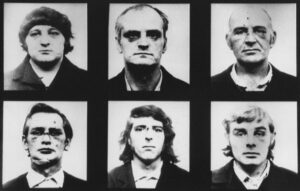 from testing people who recently touched playing cards or cigarette paper, and yet these men were convicted of a bombing based on that same lack of credible evidence. Even with all that information, it took until March 1991, before the people across Britain and Ireland began calling for their release. Finally, they were freed after years in prison. They were free, but their story didn’t end there. Seven years later, a British court of appeals formally overturned their sentences, citing serious doubts about the legitimacy of the police evidence and the treatment of the suspects during their interrogation. The six men were later awarded compensation ranging from £840,000 to £1.2 million.
from testing people who recently touched playing cards or cigarette paper, and yet these men were convicted of a bombing based on that same lack of credible evidence. Even with all that information, it took until March 1991, before the people across Britain and Ireland began calling for their release. Finally, they were freed after years in prison. They were free, but their story didn’t end there. Seven years later, a British court of appeals formally overturned their sentences, citing serious doubts about the legitimacy of the police evidence and the treatment of the suspects during their interrogation. The six men were later awarded compensation ranging from £840,000 to £1.2 million.

